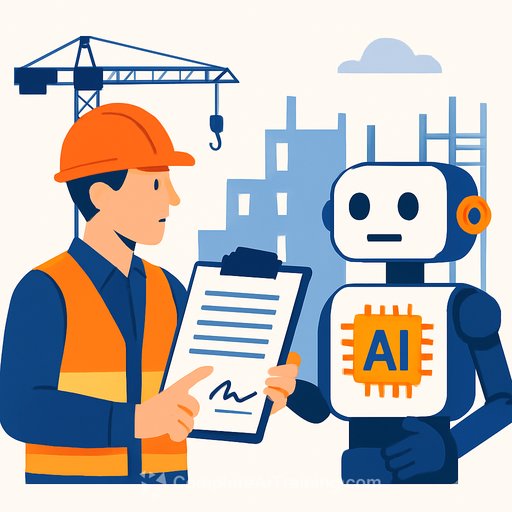AI in Construction: Builder Beware
AI is showing up in preconstruction, schedules, procurement, site monitoring, safety, and maintenance. It can speed up decisions and cut waste. But it also introduces new failure modes that can cost you time, money, and credibility.
Use AI like a power tool: helpful in skilled hands, dangerous without controls. The goal is fewer surprises, not blind faith in a black box.
Where AI Helps Today
- Precon estimates and takeoffs (as a second set of eyes, not the final number)
- Schedule simulations with scenario analysis
- Photo and video analysis for progress tracking and safety observations
- Document search across RFIs, submittals, specs, and codes
- Predictive maintenance on building systems
Where AI Bites Builders
- Inaccurate outputs that look confident (bad estimates, wrong sequencing, flawed clash notes)
- Liability if work follows faulty AI guidance without human review
- Data exposure: tenant, employee, and jobsite data in third-party tools
- IP risks tied to training data and generated outputs
- Overreliance on opaque models with no audit trail
Data and Bias: Quiet Risk, Loud Consequences
AI learns from historical data. If the data underrepresents your building type, climate zone, or local methods, the model will be less reliable. Bias can also creep into safety alerts, risk scores, or tenant screening signals.
Small, complex, or one-off projects are frequently outliers. Treat them as higher-risk for AI-assisted decisions.
Contracts and Compliance: Close Your Gaps
- Scope and standard of care: clarify where AI is used and who approves final outputs
- Indemnity and warranties: define responsibility if AI-driven work causes errors or delay
- IP and data rights: who owns outputs, training rights, and derivative works
- Privacy and security: data processing addenda, retention limits, and breach duties
- Vendor disclosures: model limitations, evaluation metrics, and change notices
Track regulatory shifts. The NIST AI Risk Management Framework offers practical guidance. If you operate in the EU (or with EU data), keep an eye on the AI Act.
Field-Ready Governance Playbook
- Human-in-the-loop: assign accountable reviewers for every AI-assisted decision
- Validation: test AI on past projects and compare against known outcomes
- Change control: document model versions, prompts, and settings used
- Audit trail: log prompts, outputs, and approvals; store with project records
- Guardrails: define "no-go" zones (e.g., stamped plans, load calculations, lockout/tagout)
- Incident response: playbook for bad outputs, data leaks, or vendor outages
Vendor Due Diligence: Questions That Save You Later
- Training data: sources, recency, regional coverage, and known gaps
- Performance: error rates, test sets, and how they measure real-world accuracy
- Security: encryption, access logs, subcontractors, data retention, and deletion
- Reliability: uptime SLA, support windows, and rollback plans
- Legal: IP indemnity, privacy terms, warranty scope, and liability caps
- Transparency: change logs and alerts when models or terms update
Insurance: Update It Before You Need It
- Professional liability: confirm coverage for AI-assisted design or recommendations
- Technology E&O: consider if you build internal tools or offer AI services
- Cyber: include third-party processor incidents and data restoration costs
- Builder's risk and general liability: check exclusions that could touch AI
Practical Workflows That Work
- Use AI to summarize submittals and specs, then have engineers verify critical points
- Draft RFIs and change order narratives with AI, but route through standard approvals
- Auto-tag site photos for progress; PM verifies quantities before payment apps
- Run schedule "what-ifs" with AI, then baseline only after superintendent review
Skip AI for stamped engineering, load paths, safety-critical lockout decisions, or anything that bypasses licensed judgment. That's where human expertise stays non-negotiable.
Case Snapshots
- A mid-rise schedule bot compresses durations based on ideal crew sizes. The GC catches it in review and adjusts for local labor shortages, avoiding a misleading critical path.
- An AI estimator misses local escalation on specialty glass. Cross-check against supplier quotes prevents a six-figure miss before GMP.
- Safety alerts overflag PPE violations on night shots. The team retrains with jobsite-specific images, cutting false positives in half.
30-60-90 Day Plan
- Days 1-30: Pick two use cases with low risk (document search, photo tagging). Set review owners. Turn on logging.
- Days 31-60: Pilot with past projects. Compare output to actuals. Fix prompts, add checklists, and define no-go zones.
- Days 61-90: Bake governance into SOPs. Update contracts and insurance. Expand to schedules or estimates with strict reviews.
Bottom Line
AI can speed up work and sharpen decisions, but it doesn't remove accountability. Keep humans in charge, document everything, and close legal gaps before you scale.
If your team needs structured upskilling, see practical options by role here: AI courses by job.
Your membership also unlocks:






